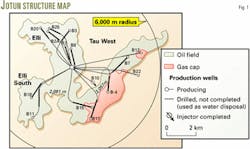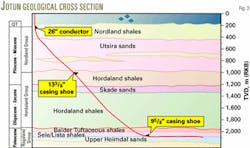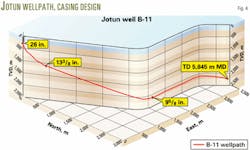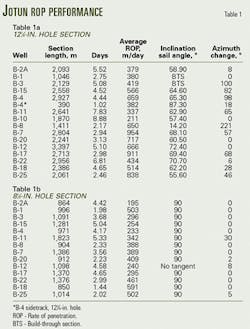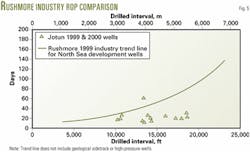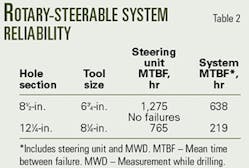Rotary steerable, directional-drilling systems increased rate of penetration (ROP) and saved more than 100 days of rig time when used to drill complex 3D wellpaths in the 121/4-in. and 81/2-in. hole sections of Jotun field development wells, compared to conventional directional-drilling systems.
The Jotun field lies 165 km off Norway in 127 m of water. Esso Norge AS developed the field, from a wellhead platform using a fit-for-purpose, new-build drilling rig, with complex directional horizontal producers in the Paleocene, Heimdal sandstones at about 2,050 m TVD subsea.
Drilling operations experienced no hole problems or wellbore instability during the 15-well Jotun drilling campaign. The company attributed the success to improved hole cleaning from drill-pipe rotation, as opposed to sliding, and to faster drilling times that reduced shale instability risks.
Rotary-steerable systems provided greater directional-steering accuracy and drilling efficiency in extended-reach drilling applications because drillstring sliding in the wellbore was not required to maintain directional control.
Rotary steerable technology
The Jotun field reservoir target complexity dictated that the company use tortuous directional well paths often resulting in azimuth changes in excess of 90° at high angle horizontal inclinations, making directional drilling essential.
Target tolerances on the order of 1 m were commonplace at measured depths out to 6,000 m. Directional control and well tortuousity were critical well design considerations.
The amount of directional drilling a well requires has a significant impact on the drilling ROP that the operator can achieve over a hole's section.
Conventional directional-drilling techniques do not allow drillstring rotation while the well path is being oriented. The drillstring must slide in the wellbore until the path correction achieves the desired direction and inclination.
Rotary-steerable technologies that allow drillstring rotation during directional drilling greatly improve the effective penetration rate, particularly on longer extended-reach wells where friction between the wellbore and drillstring makes sliding difficult.
The company's objective in using rotary-steerable systems for the Jotun field development was to achieve lower cost wells through reduced drilling times.
Esso Norge entered into an agreement with Baker Hughes Inteq to use the AutoTrak rotary-steerable technology on all 12 1/4-in. intermediate and 8 1/2-in. horizontal hole sections in the Jotun-B platform wells.
Drilling commenced in April 1999, making Jotun the first field to be developed with rotary-steering technology. Esso Norge has drilled 1 water-injection well and 14 horizontal production wells for the Jotun-B platform.
Jotun field development
The 14 oil producers, drilled from the Jotun wellhead platform, access oil reserves from the Heimdal reservoir and produce to a floating production storage and offloading facility.
Esso Norge positioned the Jotun B platform to allow well access to each of the three Jotun reservoirs within a 6,000 m horizontal distance.
The company had to design complex 3D well paths to place each of the horizontal wellbore completions in the reservoirs at the required orientations, minimizing the number of wells needed for reservoir drainage (Fig. 1).
Achieving plateau production as early as possible required that the rig drill and complete the first four wells in the Jotun development before the scheduled start-up of the production facility.
With the large amount of directional drilling required to achieve the necessary inclination and azimuth changes in the first wells, maximizing ROP performance while directional drilling offered a significant opportunity for the new rotary-steerable technology.
At the time of contracting the rotary steerable system, engineers had limited data available for ROP comparison with the 8 1/4-in. size tool used in drilling 12 1/4-in. intermediate hole.
They recognized that for the first wells in the program, however, they could at least achieve breakeven ROP performance. Tool reliability, for which limited data were available, posed the greatest risk to performance.
To secure tool availability and mitigate tool reliability risks, Esso Norge committed to using the rotary-steerable system for all of the 12 1/4-in. hole sections. The 12 1/4-in. hole section was chosen for the following reasons:
- It had the greatest amount of directional drilling and provided the best opportunity for ROP improvement.
- It was being drilled through a tertiary shale section, which can be time sensitive, providing the best opportunity to limit hole problems.
- It had the potential to be drilled in one bit run if trips were not required for directional assemblies.
The company also used the rotary-steerable system in all 8 1/2-in. hole sections, a procedure that was not part of the original commitment.
Engineers originally estimated that the operating company would realize marginal benefits from rotary-steerable systems when drilling the 8 1/2-in. hole section because of the small amount of directional drilling planned.
Well design issues
To achieve the desired production rates, the well completion designs called for standalone, wire-wrapped screens in the horizontal hole sections made from 6 5/8-in. base pipe (7.41 in. OD).
The required production well completions made it necessary to drill 8 1/2-in. horizontal sections, with 1,000-1,800 m horizontal laterals for each well in the Heimdal reservoir. Fig. 2 shows the cross sectional view of Jotun well B-11.
Engineers designed all of the producing wells with 9 5/8-in. intermediate casing set just into the Heimdal reservoir.
Because each of the wells required a specific 8 1/2-in. horizontal section orientation, within one of the three reservoirs, the rig had to drill the 12 1/4-in. hole sections to a planned azimuth and a build angle near horizontal, before setting the 9 5/8-in. casing.
The well plans landed the 12 1/4-in. hole sections in the reservoir at an inclination of about 85°, with the 9 5/8-in. casing typically set at 4,000-4,500 m MD.
In all of the 12 1/4-in. hole sections, the rotary-steerable system built angle, following drill-out from the surface casings, to the required 65°-75° inclination sail angle.
Drillers maintained the sail angle, changing the well path azimuth as required to be on the specified orientation for entering the reservoir. The driller would finally build inclination to near horizontal once the wellbore had attained the required orientation.
Some of the well paths required azimuth adjustments of up to 110° to achieve the reservoir entry target. The well path designers targeted the dogleg severity to 3°/30 m in the 12 1/4-in. hole sections.
Esso Norge drilled all 12 1/4-in. and 8 1/2-in. hole sections with an oil-based drilling fluid, through the Hordaland shale. Fig. 3 provides a cross sectional outline of the geological stratigraphy in the Jotun field.
All wellbore designs called for the surface casing to cover the Utsira sand, which extends through a 500 m interval to about 1,050 m TVD.
Drilling the 17 1/2-in. surface hole with water-based drilling fluid through the 26-in. conductor pipe, the well path built angle to achieve 40°-50° inclination through the unconsolidated Utsira sand.
Drillers used a conventional 1.4° bent-housing motor in the 17 1/2-in. hole section for the initial well kick off.
The rig set 133/8-in. surface casing in the Hordaland shale. The operator kept a 185/8-in. casing string available as contingency for the surface hole, but it was not required.
Fig. 4 shows an overview of a typical Jotun casing configuration and well path. The 12 1/4-in. hole sections in the Jotun development wells provided the greatest opportunity for a rotary-steerable drilling system.
Each of the hole sections, ranging 3,000-3,500 m in length, required a lot of directional work in both azimuth and inclination change, at measured depths in excess of 4,000 m.
With softer tertiary shales consistent and homogenous throughout the area, engineers designed all 12 1/4-in. hole sections to be drilled in one PDC bit run.
Performance, 12 1/4-in. hole
Previous experience in the Jotun area had shown that conventional mud-motor directional drilling required the use of tricone bits to maintain directional control. The rotary-steerable drilling system, however, maintained directional control with PDC bits.
Rotary drilling allowed the rig to maximize penetration rates while achieving doglegs of 3°/30 m. At no time did the rig have to sacrifice ROP to maintain directional control.
Table 1a provides a summary of the rotary-steerable system ROP performance in the 12 1/4-in. hole sections, with the best ROP over a 2,804 m interval of 953 m/day. The total program achieved an average ROP for the 12 1/4-in. hole sections of 507 m/day.
Esso Norge's previous experience in the area, using conventional directional-drilling systems, yielded an average ROP performance of 198 m/day.
The ROPs reported in Table 1a represent the total time, including non-productive time, to complete the 12 1/4-in. section from drill-out to casing point.
Table 1a also includes a summary of the sail angle and azimuth change required in the 12 1/4-in. hole section to achieve the desired horizontal section orientation.
These indicators provide a summary of the ROP achieved over the 12 1/4-in. hole section with the degree of directional drilling required.
The operator achieved the best ROP performance at Jotun in a drilling day (midnight to midnight) of 1,378 m and experienced no stuck pipe or tight-hole incidents in any of the 12 1/4-in. hole sections.
Drilling operations employed 5 1/2-in. drill pipe with high-torque connections and oil-based invert drilling fluids to drill all of the 12 1/4-in. hole sections, maintaining flow rates of 3.6 cu m/min and a rotary speed of 140-150 rpm.
Performance, 8 1/2-in. hole
Table 1b provides a similar comparison for each of the Jotun well 8 1/2-in. horizontal hole sections with the best ROP achieved over this interval of 591 m/day and a total program average ROP of 329 m/day.
Esso Norge's previous experience in the area, using conventional directional-drilling systems, yielded an average ROP performance of 281 m/day. The ROPs reported in Table 1b represent the total time, including nonproductive time, to complete the 8 1/2-in. section from drill-out to final total depth (FTD).
The company experienced large variations in ROP performance, while drilling the 81/2-in. hole sections, due to hard stringers and porosity variations in the Heimdal reservoir.
Drillers used the 6 1/4-in. rotary-steerable tools to drill all of the 8 1/2-in. hole sections.
As the drilling program progressed, the benefits of the rotary-steerable system in the horizontal wellbore section became evident.
To locate the horizontal section as close to the top of the reservoir as possible, the operator required steering accuracy sufficient to place horizontal sections within a 1 m window.
The rotary-steerable system was able to achieve the required accuracy and place the horizontal sections within the geologically complex reservoirs, without reduction in ROP.
Although the 8 1/2-in. horizontal sections could have been drilled with conventional directional-drilling systems, the rotary-steerable system provided ROP improvement over the conventional systems.
Drillers did not have to compromise ROP in the 8 1/2-in. hole section at any point due to an inability to steer an assembly.
The company drilled the longest 81/2-in. hole section at Jotun, 1,823 m, with one bit run from drill-out to FTD. Esso Norge used PDC bits to drill all 81/2-in. hole sections. Pump rates averaged 1.5-2.0 cu m/min, with rotary speeds of 140-150 rpm.
Fig. 5 provides an analysis of offset drilling time performance achieved in the North Sea for development wells drilled during the time of the Jotun drilling program, from April 1999 to January 2001.1
The company achieved drilling performance at Jotun, exceeding other performance in the area, with Fig. 5 ROP performance representing the ROP over the entire well to FTD.
Esso Norge originally planned to use conventional directional-drilling systems for the Jotun drilling program, estimating drilling times based on other Esso experience in the Jotun area that did not use rotary-steerable systems.
When compared against the offset wells, the company estimates it saved about 100 rig days from what it had planned and credits the savings to the rotary-steerable directional drilling technology.
Tool reliability
During the Jotun drilling program, rotary-steerable systems drilled 35,600 m of 12 1/4-in. hole-section intervals. Of the 16 different 12 1/4-in. hole sections, the systems drilled eight of them in one continuous run from drill-out to TD, with the longest section drilled in one run of 3,400 m.
Seven system failures occurred in 12 1/4-in. hole sections, resulting in a mean-time-between-failure (MTBF) of 219 hr.
High sleeve rotation occurred in one of the first Jotun wells. The nonrotating sleeve, which provides the necessary force acting on the wellbore wall to obtain the desired dogleg, experienced 20 revolutions/hr compared to the normal 2-8 revolutions/hr.
Tool designers modified the steering pads by cutting grooves to increase friction between the pads and the formation face. The modification proved successful and was incorporated as a standard for soft formations.
Esso Norge drilled 14 horizontal 8 1/2-in. hole sections, with 12 of sections drilled in one continuous run from drill-out to FTD. The company drilled 16,000 m of 8 1/2-in. hole, resulting MTBF of 638 hr, which is equivalent to 8,000 m of hole between failures.
Because of hard formations and the need to control the drilling process to obtain formation evaluation data, drilling ROP slowed compared to the 12 1/4-in. sections.
Table 2 highlights the rotary-steerable system reliability for the steering unit alone as wells as for the entire system, which includes the MWD sensors, gamma ray, and resistivity sensors.
Hole conditioning benefits
Rotary-steerable systems generate hole-conditioning benefits, which:
- Improve hole-cleaning capability over sliding, when rotary drilling at 140-150 rpm.
- Results in a stabilized bottom-hole assembly.
- Minimizes hole-open time, reducing wellbore instability potential.
- Reduces torque and drag and creates a smoother wellbore.
Torque values did not exceed 30,000 Newton-m at any point during drilling of the Jotun wells, which was the maximum seen at FTD in an 8 1/2-in. hole section. In the 12 1/4-in. hole sections, drillers recorded the highest torque value at 28,000 Newton-m.
Engineers have calculated two sets of friction factors for the drag and torque data. Pickup and slack off data, from the 8 1/2-in. and 12 1/4-in. openhole sections, yield a friction coefficient of 0.21. From rotating torque data the friction coefficient calculated to be 0.16.
Both the torque values and the calculated friction coefficients were lower than engineers had expected. Esso Norge established the practice of using 5 1/2-in. drill pipe in the 9 5/8-in. casing and running 1,400 m of 5-in. pipe in the horizontal sections, while drilling the horizontal hole.
Engineers believe the low friction factors were attributed to the smoother wellbore and better hole cleaning achieved with the rotary-steerable drilling system.
Although the benefit is not possible to quantify, the ability to rotate the drillstring for an entire wellbore section at 140-150 rpm did aid hole cleaning.
Wire-wrap screens, run in all 8 1/2-in. horizontal completion sections, encountered no hole problems that could be attributed to poor hole cleaning during drilling or completion phases of the Jotun program.
Acknowledgments
The authors thank the members of the Jotun joint-venture: Enterprise Oil, Norske Conoco AS, det Norske Oljeselskap AS, Statoil ASA, Esso Norge AS, and Baker Hughes Inteq for permission to publish the experience obtained during Jotun development drilling.
Reference
- Rushmore Associates and the Sigma Consultancy, "European Drilling Performance Review 1999," Helen@ RushmoreReviews.com
The authors
Morten Grini is a drilling and completions engineer for Esso Norge AS. He has an MS in petroleum technology from the Norwegian University of Technology & Science (NTNU) and has worked for Esso Norge since graduation in 1998.
W. V. Rice is a drilling operations superintendent for ExxonMobil Canada. He joined Imperial Oil Canada as a drilling engineer working in Western Canada. His work experiences include assignments in the Canadian Arctic, Saudi Arabia, and Norway. He has a BS in mineral engineering from the University of Alberta in 1977.
Svein Strømberg is operations manager for Baker Hughes Inteq with primary responsibility for drilling operations in Norway and Denmark. He completed an MS in petroleum engineering from H gskolen in Stavanger in 1988.

